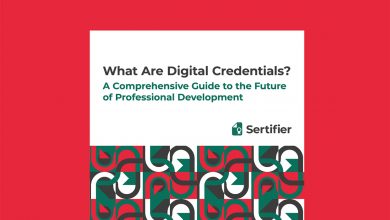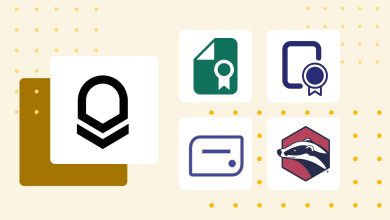How to Choose Digital Credentialing Software?
Table of Contents
Intro
Every element of our workflow becomes more and more digitalized as time passes by, including credentials. Hard-copy certificates and badges are left behind, and it is time to carry our organization’s credentialing process to the next level. Many businesses prefer digital credentialing softwares because of many benefits: Automated credentialing process, business growth, skills management, and gamification. It is sometimes hard to believe how they can be beneficial in multiple ways for your business. However, there are many real-life examples that indicate how businesses and organizations from various industries can utilize this software.
Besides its countless benefits, digital credential industry is growing continuously, and it is possible to find a great number of digital credentialing platforms, each offering various digital credentialing solutions. With the diversity of solutions available, it is rather difficult to choose which platform to incorporate in your workspace. This article will help you with the basics, the key points to consider, and which actions to take while decision-making. So, keep reading to learn more about certifications and how to handle an effective decision-making process in terms of selecting digital credentialing software.
What is a Digital Credentialing Solution?
Before diving into the endless conversations with the people you don’t know, you have to know about what these solutions are, and what digital credentialing softwares do in the first place. Without knowing what you are searching for, it is not possible to find a great solution either.
Sometimes people can feel biased because “they are not tech-proficient”, and refuse to learn about digital credentialing softwares. Let us assure you: It is not rocket science. On the other hand, it is not a mere process of sending certifications with cute designs to a bunch of people.
Certifications are the outcome of a number of various sub-processes, each of which brings various benefits to your organization. Sending credentials includes skills management, audience analysis, marketing campaigns, credential design, and so forth.
digital credentialing consists of two main elements: digital certifications and online badges. You may already know about digital credentialing, but let’s have a look at what these two terms mean.

Digital Certification
A digital certification is a secure, verifiable digital credential issued by a trusted authority that proves an individual’s achievements, skills, or qualifications online. Digital certifications replace traditional paper certificates, ensuring trust and security in digital interactions.
Digital Badging
Online badges serve as dynamic visual representations of skills and accomplishments. They encapsulate the specific criteria and evidence required to earn them, providing a comprehensive and detailed overview of an individual’s capabilities.
The whole process seems to be a painstaking process, yet, there are a number of online platforms that provide their customers with various solutions. Although the platform handles the painful work for you, with the current state of the digital credentialing industry, it is hard to find the best solution for your organization. There are a number of digital credentialing software such as Sertifier, Accredible, and Credly. To find the best fit for your organization, you should pay close attention to your needs and wants, which is a whole other process that is as significant as the solution itself.
Feature Set: Identify Must-Have vs. Nice-to-Have
The most crucial part of finding a certification solution for your organization is the feature set. The feature set determines the overall functionality and efficiency of the digital credentialing software. Considering the effort, time, and budget that you’ll invest into the platform, the selected platform has to bring the most efficient benefits possible. So, if you haven’t done so, please write down your “must-haves in detail, so you will easily figure out what will be the most beneficial. Your must-have list needs to include your essential needs, such as integrations, analytics & reports, and customer support. You may add other essential features depending on your organization’s expectations and needs.
After that, you should figure out what is nice to have, in other words, what can bring benefits that are beyond your expectations and needs. In this way, you will have a clean mind that will guide you to determine which features of the digital credentialing software would fit the best.
Each feature set may concern a different teammate from your organization. For instance, integrations may concern your development team, and analytics and reports may concern your marketing team. So, take your teammates who may take part in the certification process into account during the decision-making process.
Let’s take a closer look at the essential features of a platform to give you a vivid idea for your must-have list.

Integrations: Does the Platform Work with Existing Systems?
The integrations are the most important feature of digital credentialing software. Considering what is included in the existing workspace of your organization, the digital credentialing platform has to be the most integrable one with your long-used apps, platforms, and services. To give an idea, most integrated platforms can be counted as Zoom, Blackboard, Google Classroom, Zapier, Thinkific, Mini-Course Generator, Microsoft Teams, Degreed, Coursera, SkillJar, and so on. Many platforms provide an extensive integration library, however, you may need custom integrations and/or a new integration that is not yet available.
An extensive integration library that includes the apps you’ve already been using in your workspace, is a discriminative key point that indicates a potentially great digital credentialing software. Take your time and search for the apps in the integration libraries of your digital credentialing solution candidates. Note down what is available and unavailable. You need to figure out which integrations you will request from your solution options. The responses to these requests will provide you with the notion of great customer service.
In addition, check if the platform has an API for custom integrations. You may not have any technical knowledge regarding software development, however, you need to look for proper API documentation. You may ask for help from your developer team to check if the API documentation is detailed enough. This is another significant point in the decision-making process.
Analytics and Reports: What Can You Do With Data?
Everything starts after the credentials are sent to your recipients. You should be aware that credentials bring many more benefits than you think. Even the simplest certification carries a lot of information that has the potential to reconsider your business plan, product roadmap, marketing campaigns, social media usage, team management, and so forth. An efficient digital solution has to provide you with analytics tools and audience reports for further consideration and analysis. Basically, they have to provide you with everything a hard-copy certification can not.
After sending an online credential to your recipients, you need to know what kind of benefits and ideas you can cultivate from the information of your audience. What kind of people? Which job titles? How many and what kind of skills? What are the share rates? How can you achieve brand visibility through social media shares? How many people added their credentials from your organization to their LinkedIn profiles? How many people downloaded their certificates? These are crucial questions that can generate a great number of benefits for your organization. However, it is not efficient for you to go over all the data you got on an Excel spreadsheet. Instead, the digital credentialing software that you will choose has to do the job for you. The efficiency of analytics tools provided by digital credentialing softwares accelerate the data analysis process and saves you a lot of time. Remember, you have limited time that you should make good use of.
However, you may still need to access and work on old-school Excel spreadsheets. If that is the case, look for what kind of reports the digital credentialing software provides. Will you be able to export these reports to Excel? Is the data clean and organized enough for data analysis? Because of that, you should also seek audience reports besides analytics tools.

Support: What Level of Support is Provided?
Most businesses need instant access to support channels provided by digital credentialing platforms. Before deciding which digital credentialing software to continue with, you should take your time and go over the platforms’ support channels provided. Will you be able to connect to a customer support agent if you are in a hurry? Is there a help center that provides you with articles, and video guides for your questions? How detailed and specific are these help center content? These are the questions that should be asked and answered. Depending on the answers, you may get the idea of whether the platform has great customer support or not.
Besides first-hand assessment of the customer support channels, it is always a good idea to check the digital credentialing software’s user reviews. You can check platforms like G2, Capterra, ProductHunt, and Crozdesk for other people’s reviews and ratings. On the other hand, you should pay close attention to detect any fake reviews and ratings that can trick you. Unfortunately, some platforms refer to fake reviews and bots to boost their metrics.
Credibility, Verification & Data Security: How can you achieve brand credibility via Credentials?
Digital certifications can be taken into account as the visible side of your organization. They add a great amount of credibility when provided by a credible digital credentialing software. Beware that as they bring credibility to your organization, they also provide assurance for your recipients that they can use their credentials in their job applications, and confidently share their achievements with their network.
Credentialing fraud is a real thing, and organizations have to prevent it by using credible digital credentialing softwares. To prevent any fraud, check for certifications that provide compliance, such as ISO27001. On the other hand, if a badge service is provided, you have to make sure that they are Open Badges 2.0 compliant. If you are confused about how the platform provides credible credentials, check if there are any articles and/or blog posts regarding their credibility. Also, it is also a good idea to check SaaS review platforms to detect if there are any credibility concerns and issues.
The credibility of the platform is a concerning point on your end, however, there is also your recipients’ end that you should take into account. When they achieve a credential via your organization, your recipients will want to see their credential details and verify their credentials. The digital credentialing software you will choose has to provide you with a credential verification portal to allow your recipients to store and verify their credentials with ease.
In addition, your recipients will be concerned about the security of their data implemented into their credentials. Consider what kind of information that you will use in your credentials, and look for how the data will be secured. To prevent any issues such as identity theft and data leaks, the digital credentialing softwares have to take precautions against issues that may endanger your data. Make sure that your data is not sold to anyone, not used by any 3rd parties without your permission and kept secure.

Steps to Take Before Deciding on Digital Credentialing Software
Now that you have learned about the basics and what your needs and wants would consist of, it is time to take action to find the best fit for your organization.
No matter how complicated and difficult it seems to decide which digital credentialing platform to choose, Sertifier provides you with a great guide to set up your decision-making process and find the best solution for your organization. Simply follow the steps below and see how efficient the process becomes.
Step 1 | Write down what your needs and wants are
Before diving into a dense research of digital credentialing softwares, you have to know what you need and want. Your list should include what is must-have and nice-to-have. It is super beneficial to know what you actually need, in other words, you can’t do without. This list must include your essential requirements such as your audience size, how often you will send credentials in a year, how many credentials will be sent in a year, what kind of integrations you will need to use, what your budget is, and any other thing that you consider as the key-point.
When you are done with your must-have list, it will be also important to have a nice-to-have list. Remember that you will invest a considerable amount of money into a digital credentialing software, and you need to know what bonuses you will utilize besides the main features. Does the platform have any perks such as discounts on other platforms? What kind of resources do they provide? Will they be open to any further partnerships in the future? These questions are just examples, and your questions will be determined depending on what you aim to achieve besides the main benefits. In addition, take your organization’s dynamics into consideration while writing down your nice-to-have list. If all the platforms have similar or close main feature sets, these perks (or bonuses) will help you decide which one to choose.
Step 2 | Look for clues online
The Internet is the best place to find clues regarding the nature of digital credentialing software. Visit app review platforms, read what other people talk about, and do a little social media research about which platforms’ credentials are the most shared and liked. When brought together, these scattered bits of information will provide you with a great idea of how a digital credentialing platform differentiates from its competitors. Many review platforms include comparison tools to compare the pros and cons of multiple digital credentialing softwares at once, so it might be a good idea to take benefit from them.
In the end, if the internet loves the platform, it should add positive feelings and notions to that digital credentialing software’s account. However, pay close attention to the credibility of the review platforms. Unfortunately, some platforms make use of bots and fake reviews to boost their metrics and ratings. So, don’t let them trick you for what does not exist. Some credible review platforms where you may find useful reviews and compare digital credentialing softwares are G2, Capterra, and Crozdesk.
Last but not least, don’t skip what is actually happening out there on social media platforms regarding online credentials. You may utilize LinkedIn posts and profiles to find clues regarding each digital credentialing software. As a hint, you can search for credentials shared by real people on Linkedin. What kind of certifications are issued through the platform? How many likes, shares, and comments are gained? To what extent did the existing customers benefit from the platform? These are some questions that may help you figure out if digital credentialing software is actually beneficial for an organization.
It’s effective to analyze the actual reactions of people on social media, which directly impacts an organization’s brand visibility and marketing process. On the other hand, fake credentials indicate a questionable state of credibility of the digital credentialing software. At the end of the day, the customers of a business define what the business is up to.
Step 3 | Read the platforms’ blogs to cultivate information
Almost all digital credentialing softwares already have their blogs, full of information regarding their platform. Don’t skip going over these platforms and don’t forget to ask specific questions you have on your must-have and need-to-have lists. Before talking to a real person from the sales team, reading their blogs and learning about their platform will enhance the benefit of the demo session. In addition, reading blog posts will give you new ideas and may generate new questions that you are not yet aware of. While going through the blog posts of the platform, don’t forget to take notes and revise your must-have and nice-to-have lists if needed.
Step 4 | Book a demo with the team
You have done your research and got what you can get by yourself. Now it’s time to sit and talk with a real person from the sales team. Check the digital credentialing software’s landing page to find a demo form and schedule a demo session. Ask your team members if anybody else wants to join the demo session, and fill out the form. Gather all your notes and questions before the demo session.
During the session, allow the person from the sales team to give you information about the digital credentialing software. They will ask about your needs and expectations. Now, it is time to uncover the information you have already gathered, talk about your must-have and need-to-have lists, and ask questions. Do not hesitate to ask follow-up questions and ask for detailed explanations.
The demo session has the best atmosphere to discuss what the digital credentialing software can do for your organization. Ask for their product roadmap: What are they up to? Ask for integration requests: Can they rearrange their product roadmap according to your integration request? How much will it take to develop your integration? These are some generic questions that we encounter the most during Sertifier’s demo sessions, so they should give you a great hint to decide what to ask in detail. Be specific as possible to prevent any misunderstandings. At the end of the session, request the contact information of the people that guided you.
After the session, keep in touch with the sales team. Don’t forget to notify the team regarding any updates on your end. If needed, do not hesitate to ask for further information that you may have forgotten during the demo session.
Step 5 | Determine what the pros and cons are for each digital credentialing software
Finally, it is time to decide which platform to continue with. With all the information you have gathered and the outcomes of the demo session, you need to make a pros and cons list for each credentialing software. Whilst making these lists, don’t skip to consider your must-have and need-to-have lists. Your must-have lists should constitute the key points in your decision-making, so it would be nice to mark any pros that are equivalent to your must-haves. Then it’s finally time to decide which solution you will choose. Keep in touch with the team members for a clean payment and onboarding process.
Conclusion
Although it takes a lot of effort to find the best digital credentialing software for your organization, there is always the right way to do it. Considering their potential and actual benefits, digital certifications are worth the effort, time, and money you invest into. On the other hand, your effort, time, and money are valuable, and you should make the right decision to spend them in the most beneficial way. You should be able to eliminate any struggle points that may get in the way, and prevent any harm that may impact your organization. It is a big risk to search for crucial solutions on the internet, considering the questionable credibility of the resources. It is not -mostly- possible to handle such meetings face-to-face anymore, and you should be able to trust into whom you invest your effort, time, and money.
As the team of Sertifier, we hope that we’ve succeeded in providing you with an efficient guide that will help you find the best digital credentialing software in your decision-making process. You can visit our website, blog, and help center for further information. Also, do not hesitate to reach out through info@sertifier.com for any questions you may have.



